技术分享 | i.MX8M Mini适配MIPI转eDP芯片
1. 方案概述此方案使用HD-8MMN-CORE的核心板搭配TI公司的芯片SN65DSI86转换芯片实现。SN65DSI86作为一款MIPI DSI转eDP的芯片,支持双通道DSI输入,最大四通道显示输出,最大支持4K@60fps输出,WUXGA 1080P。本方案中将采用单通道DSI输入,双通道DP输出到1080p的屏幕。HD8MMN-CORE系列工业级核心板基于NXP(Freescale) i.MX8MM系列Cortex-A53高性能处理器设计,支持硬件加密,支持摄像头接口、USB3.0接口、HDMI/MIPI、PCIe、千兆以太网接口、多路串口等,适用于快速开发一系列最具创新性的应用,如多媒体应用、人机界面、工业4.0、车载终端以及边缘计算设备等。 2硬件原理图
 注:硬件修改REFCLK上需要贴上27M的晶振,TEST2引脚需要通过4.7K电阻上拉到1.8V.3软件实现3.1软件介绍l 内核版本:Linux5.10;l SN65DSI86驱动:drivers/gpu/drm/bridge/ti-sn65dsi86.cl Panel驱动:drivers/gpu/drm/panel/panel-simple.c 3.2驱动移植内核配置,需要打开如下两项
注:硬件修改REFCLK上需要贴上27M的晶振,TEST2引脚需要通过4.7K电阻上拉到1.8V.3软件实现3.1软件介绍l 内核版本:Linux5.10;l SN65DSI86驱动:drivers/gpu/drm/bridge/ti-sn65dsi86.cl Panel驱动:drivers/gpu/drm/panel/panel-simple.c 3.2驱动移植内核配置,需要打开如下两项CONFIG_DRM_TI_SN65DSI86=y
CONFIG_DRM_PANEL_SIMPLE=y
1) 设备树配置
/ {
osc_27m: clock-osc-27m {
compatible =
"fixed-clock";
#clock-cells = <0>;
clock-frequency =
<27000000>;
clock-output-names =
"osc_27m";
};
lcd_backlight: lcd_backlight {
compatible =
"pwm-backlight";
pwms = <&pwm1 0
100000>;
status = "okay";
brightness-levels = < 0 1
2 3 4
5 6 7
8 9
10 11 12
13 14 15 16 17 18 19
20 21 22
23 24 25 26 27 28 29
30 31 32
33 34 35 36 37 38 39
40 41 42
43 44 45 46 47 48 49
50 51 52
53 54 55 56 57 58 59
60 61 62
63 64 65 66 67 68 69
70 71 72
73 74 75 76 77 78 79
80 81 82
83 84 85 86 87 88 89
90 91 92
93 94 95 96 97 98 99
100>;
enable-gpios = <&gpio1 1
GPIO_ACTIVE_HIGH>;
default-brightness-level =
<80>;
};
panel {
compatible =
"test,test-edp-1080p";
//设置自己的屏幕匹配参数组
backlight =
<&lcd_backlight>;
no-hpd;
port {
panel1_in: endpoint {
remote-endpoint
= <&sn65_out>;
};
};
};
};
&pwm1 {
pinctrl-names = "default";
pinctrl-0 = <&pinctrl_pwm1>;
status = "okay";
};
&i2c4
{
clock-frequency = <400000>;
pinctrl-names = "default";
pinctrl-0 = <&pinctrl_i2c4>;
status = "okay";
sn65dsi86@2d {
…….
clock-names =
"refclk"; //默认名字
//SN65DSI86
宋体;mso-ascii-font-family:" times="" new="" roman";mso-hansi-font-family:"times="" roman";="" color:black;mso-color-alt:windowtext"="">仅支持12 MHz, 19.2 MHz, 26 MHz, 27 MHz
or 38.4 MHz.
clocks = <&osc_27m>;
……
port@1 {
reg =
<1>;
sn65_out:
endpoint {
//data-lanes = <0 1 2 3>;
//
mso-ascii-font-family:" times="" new="" roman";mso-hansi-font-family:"times="" roman";="" color:black;mso-color-alt:windowtext"="">根据eDP
宋体;mso-ascii-font-family:" times="" new="" roman";mso-hansi-font-family:"times="" roman";="" color:black;mso-color-alt:windowtext"="">屏的通道数设置,这里为2
宋体;mso-ascii-font-family:" times="" new="" roman";mso-hansi-font-family:"times="" roman";="" color:black;mso-color-alt:windowtext"="">通道
data-lanes = <0 1>;
……
2) 驱动修改添加显示屏的显示参数到驱动中,修改drivers/gpu/drm/panel/panel-simple.c:
tatic const struct display_timing test_edp_1080p_timing = {
.pixelclock = { 153000000, 153000000, 153000000 },
.hactive = { 1920, 1920, 1920 },
.hfront_porch = { 100, 100, 100 },
…..
.bus_format = MEDIA_BUS_FMT_RGB666_1X18,
.connector_type = DRM_MODE_CONNECTOR_eDP,
};
static const struct of_device_id platform_of_match[] = {
{
.compatible = "test,test-edp-1080p",
.data = &test_edp_1080p,
},
修改sn65dsi86驱动以适应我们的板卡,修改drivers/gpu/drm/bridge/ti-sn65dsi86.c,修改DSI正确的模式,防止找不到注册的panel出现报错“could notfind any panel node”,开机过程中打印1次是正常的,SN65DSI86的驱动找不到Panel会被多次调用,直到找到panel为止。 margin-left:0cm">
3) 调试报错在调试过程中碰到“Link training failed, link is off”的报错,是因为SN65DSI86默认只支持ASSR模式的eDP屏幕,对于不支持ASSR模式的eDP屏,硬件上则需要将TEST2引脚拉高到1.8V,且修改相关寄存器将芯片从ASSR模式变为支持标准的DP模式,修改如下: margin-left:0cm;text-indent:21.0pt">#define SN_ENH_FRAME_REG 0x5A margin-left:0cm;text-indent:21.0pt">#define ASSR_CONTROL BIT(0) margin-left:0cm;text-indent:21.0pt">... margin-left:0cm;text-indent:21.0pt">
margin-left:0cm;text-indent:21.0pt">static int ti_sn_link_training(struct ti_sn_bridge *pdata, int dp_rate_idx, margin-left:0cm;text-indent:21.0pt"> const char **last_err_str) margin-left:0cm;text-indent:21.0pt">{ margin-left:0cm;text-indent:21.0pt"> unsigned int val; margin-left:0cm;text-indent:21.0pt"> int ret; margin-left:0cm;text-indent:21.0pt"> int i; margin-left:0cm;text-indent:21.0pt">
margin-left:0cm;text-indent:21.0pt"> /* set dp clk frequency value */ margin-left:0cm;text-indent:21.0pt"> regmap_update_bits(pdata->regmap, SN_DATARATE_CONFIG_REG, margin-left:0cm;text-indent:21.0pt"> DP_DATARATE_MASK, DP_DATARATE(dp_rate_idx)); margin-left:0cm;text-indent:21.0pt">
margin-left:0cm;text-indent:21.0pt"> regmap_write(pdata->regmap, 0xff, 0x07); margin-left:0cm;text-indent:21.0pt"> regmap_write(pdata->regmap, 0x16, 0x01); margin-left:0cm;text-indent:21.0pt"> regmap_write(pdata->regmap, 0xff, 0x00); margin-left:0cm;text-indent:21.0pt"> /* For DisplayPort, use the standard DP scrambler seed. */ margin-left:0cm;text-indent:21.0pt"> regmap_update_bits(pdata->regmap, SN_ENH_FRAME_REG,ASSR_CONTROL, 0); margin-left:0cm;text-indent:21.0pt"> /* enable DP PLL */ margin-left:0cm;text-indent:21.0pt"> regmap_write(pdata->regmap, SN_PLL_ENABLE_REG, 1); margin-left:0cm;text-indent:21.0pt"> margin-left:0cm;text-indent:21.0pt">...
如果未接eDP屏幕会出现如下报错:[
2.299284] ti_sn65dsi86 3-002d: ERROR Can't read lane
count (-6); assuming 4
[ 2.765851] ti_sn65dsi86 3-002d:
ERROR Can't read eDP rev (-6), assuming 1.1
